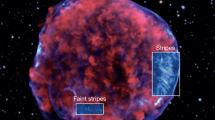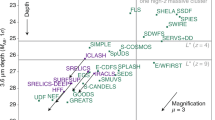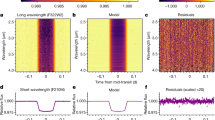Abstract
NASA’s Chandra X-ray Observatory and the ESA’s X-ray Multi-Mirror Mission (XMM-Newton) made their first observations ten years ago. The complementary capabilities of these observatories allow us to make high-resolution images and precisely measure the energy of cosmic X-rays. Less than 50 years after the first detection of an extrasolar X-ray source, these observatories have achieved an increase in sensitivity comparable to going from naked-eye observations to the most powerful optical telescopes over the past 400 years. We highlight some of the many discoveries made by Chandra and XMM-Newton that have transformed twenty-first century astronomy.
This is a preview of subscription content, access via your institution
Access options
Subscribe to this journal
Receive 51 print issues and online access
$199.00 per year
only $3.90 per issue
Buy this article
- Purchase on Springer Link
- Instant access to full article PDF
Prices may be subject to local taxes which are calculated during checkout










Similar content being viewed by others
References
Weisskopf, M. C. et al. An overview of the performance and scientific results from the Chandra X-Ray observatory. Publ. Astron. Soc. Pacif. 114, 1–24 (2002)
Jansen, F. et al. XMM-Newton observatory. I. The spacecraft and operations. Astron. Astrophys. 365, L1–L6 (2001)
Bhardwaj, A. et al. X-rays from solar system objects. Planet. Space Sci. 55, 1135–1189 (2007)Excellent overview of the progress made in this sub-discipline.
Guedel, M. & Naze, Y. X-ray spectroscopy of stars. Astron. Astrophys. Rev. 17, 309–408 (2009)Comprehensive review of the progress in stellar astronomy fostered by Chandra and XMM-Newton.
Wolk, S. J. et al. Stellar activity on the young suns of Orion: COUP observations of K5–7 pre-main-sequence stars. Astrophys. J. 160 (Suppl.). 423–449 (2005)
Vink, J. X-ray high resolution and imaging spectroscopy of supernova remnants. Proc. X-ray Universe 2005 (ESA SP-604) (ed. Wilson, A.) 319–327 (European Space Agency, 2006)
Weisskopf, M. C. & Hughes, J. P. Six Years of Chandra Observations of Supernova Remnants, Astrophysics Update 2 (ed. Mason, J. W.) 55–113 (Springer, 2006)
Revnivtsev, M. et al. Discrete sources as the origin of the Galactic X-ray ridge emission. Nature 458, 1142–1144 (2009)
Brandt, W. N. & Hasinger, G. Deep extragalactic X-ray surveys. Annu. Rev. Astron. Astrophys. 43, 827–859 (2005)
Turner, T. J. & Miller, L. X-ray absorption and reflection in active galactic nuclei. Astron. Astrophys. Rev. 17, 47–104 (2009)
Miller, J. M. et al. Stellar-mass black hole spin constraints from disk reflection and continuum modeling. Astrophys. J. 697, 900–912 (2009)
Weisskopf, M. C. et al. Discovery of spatial and spectral structure in the X-ray emission from the Crab nebula. Astrophys. J. 536, L81–L84 (2000)The clearest view yet of the entire X-ray synchrotron nebula, revealing the inner ring and bright spot near the pulsar.
Gaensler, B. M. & Slane, P. O. The evolution and structure of pulsar wind nebulae. Annu. Rev. Astron. Astrophys. 44, 17–47 (2006)
Cattaneo, A. et al. The role of black holes in galaxy formation and evolution. Nature 460, 213–219 (2009)
Clowe, D. et al. A direct empirical proof of the existence of dark matter. Astrophys. J. 648, L109–L113 (2006)Observations show that the distribution of X-ray-emitting plasma separated from that of the total mass, providing direct evidence for the existence of dark matter.
Allen, S. W. et al. Improved constraints on dark energy from Chandra X-ray observations of the largest relaxed galaxy clusters. Mon. Not. R. Astron. Soc. 383, 879–896 (2008)
Vikhlinin, A. et al. Chandra Cluster Cosmology Project III: Cosmological parameter constraints. Astrophys. J. 692, 1060–1074 (2009)Uses observed rate of growth of galaxy clusters to measure the accelerated expansion of the Universe.
Dennerl, K. X-rays from Venus observed with Chandra. Planet. Space Sci. 56, 1414–1423 (2008)
Bhardwaj, A. et al. First terrestrial soft X-ray auroral observation by the Chandra X-ray Observatory. J. Atmos. Sol. Terr. Phys. 69, 179–187 (2007)
Wargelin, B. J. et al. Chandra observations of the “dark” moon and geocoronal solar wind charge transfer. Astrophys. J. 607, 596–610 (2004)
Dennerl, K. X-Rays from Mars. Space Sci. Rev. 126, 403–433 (2006)
Branduardi-Raymont, G. et al. Spectral morphology of the X-ray emission from Jupiter’s aurorae. J. Geophys. Res. 113, A02202 (2008)
Elsner, R. F. et al. X-ray probes of magnetospheric interactions with Jupiter’s auroral zones, the Galilean satellites, and the Io plasma torus. Icarus 178, 417–428 (2005)
Branduardi-Raymont, G. Latest results on Jovian disk X-rays from XMM-Newton. Planet. Space Sci. 55, 1126–1134 (2007)
Ness, J. U., Schmitt, J. H. M. M. & Robrade, J. Detection of Saturnian X-ray emission with XMM-Newton. Astron. Astrophys. 414, L49–L52 (2004)
Ness, J. U. et al. X-ray emission from Saturn. Astron. Astrophys. 418, 337–345 (2004)
Bhardwaj, A. et al. Chandra observation of an X-ray flare at Saturn: evidence of direct solar control on Saturn’s disk X-ray emissions. Astrophys. J. 624, L121–L124 (2005)
Bhardwaj, A. et al. The discovery of oxygen Kα X-ray emission from the rings of Saturn. Astrophys. J. 627, L73–L76 (2005)
Bodewits, D. et al. Spectral analysis of the Chandra comet survey. Astron. Astrophys. 469, 1183–1195 (2007)
Schulz, R. et al. Detection of water ice grains after the DEEP IMPACT onto Comet 9P/Tempel 1. Astron. Astrophys. 448, L53–L56 (2006)
Snowden, S. L. et al. Observation of solar wind charge exchange emission from exospheric material in and outside Earth’s magnetosheath 2008 September 25. Astrophys. J. 691, 372–381 (2009)
Snowden, S. L., Collier, M. R. & Kuntz, K. D. XMM-Newton Observation of Solar Wind Charge Exchange Emission. Astrophys. J. 610, 1182–1190 (2004)
Koutroumpa, D. et al. The solar wind charge-exchange contribution to the local soft X-ray background. Model to data comparison in the 0.1–1.0 keV band. Space Sci. Rev. 143, 217–230 (2009)
Guedel, M. et al. The XMM-Newton extended survey of the Taurus molecular cloud (XEST). Astron. Astrophys. 468, 353–377 (2007)
Feigelson, E. D. et al. Global X-ray properties of the Orion nebula region. Astrophys. J. 160 (Suppl.). 379–389 (2005)
Getman, K. V. et al. Chandra Orion Ultradeep Project: observations and source lists. Astrophys. J. 160 (Suppl.). 319–352 (2005)
Guedel, M. & Telleschi, A. The X-ray soft excess in classical T Tauri stars. Astron. Astrophys. 474, L25–L28 (2007)
Tsujimoto, M. et al. Iron fluorescent line emission from young stellar objects in the Orion nebula. Astrophys. J. 160 (Suppl.). 503–510 (2005)
Favata, F. et al. Bright X-ray flares in Orion young stars from COUP: Evidence for star-disk magnetic fields? Astrophys. J. 160 (Suppl.). 469–502 (2005)
Alexander, R. From discs to planetesimals: Evolution of gas and dust discs. N. Astron. Rev. 52, 60–77 (2008)
Guedel, M. et al. Million-degree plasma pervading the extended Orion nebula. Science 319, 309–312 (2008)
Castor, J., McCray, R. & Weaver, R. Interstellar bubbles. Astrophys. J. 200, L107–L110 (1975)
Zhekov, S. A. et al. Chandra LETG observations of supernova remnant 1987A. Astrophys. J. 645, 293–302 (2006)
Zhekov, S. et al. High-resolution X-ray spectroscopy of SNR 1987A: Chandra LETG and HETG observations in 2007. Astrophys. J. 692, 1190–1204 (2009)
Racusin, J. et al. X-ray evolution of SNR 1987A: The radial expansion. Astrophys. J. 703, 1752–1759 (2009)
Laming, J. M. et al. The polar regions of Cassiopeia A: The aftermath of a gamma-ray burst? Astrophys. J. 644, 260–273 (2006)
Lopez, L. A. et al. Tools for dissecting supernova remnants observed with Chandra: Methods and application to the galactic remnant W49B. Astrophys. J. 691, 875–893 (2009)
Ho, W. & Heinke, C. A neutron star with a carbon atmosphere in the Cassiopeia A supernova remnant. Nature 462, 71–73 (2009)
Reynolds, S. P. et al. A deep Chandra observation of Kepler’s supernova remnant: A type Ia event with circumstellar interaction. Astrophys. J. 668, L135–L138 (2007)
Reynolds, S. Supernova remnants at high energy. Annu. Rev. Astron. Astrophys. 46, 89–126 (2008)
Butt, Y. Beyond the myth of the supernova-remnant origin of cosmic rays. Nature 460, 701–704 (2009)
Abuberkerov, M. et al. The Mass of the black hole in the X-ray binary M33 X-7 and the evolutionary status of M33 X-7 and IC 10 X-1. Astron. Rep. 53, 232–242 (2009)
Liu, J. et al. Precise measurement of the spin parameter of the stellar-mass black hole M33 X-7. Astrophys. J. 679, L37–L40 (2008)
Baganoff, F. K. et al. Rapid X-ray flaring from the direction of the supermassive black hole at the Galactic Centre. Nature 413, 45–48 (2001)
Porquet, D. et al. XMM-Newton observation of the brightest X-ray flare detected so far from Sgr A*. Astron. Astrophys. 407, L17–L20 (2003)
Komossa, S. et al. A huge drop in the X-ray luminosity of the nonactive galaxy RX J1242.6–1119A, and the first postflare spectrum: testing the tidal disruption scenario. Astrophys. J. 603, L17–L20 (2004)
Komossa, S. et al. Discovery of a binary active galactic nucleus in the ultraluminous infrared galaxy NGC 6240 using Chandra. Astrophys. J. 582, L15–L19 (2003)
Brunner, H. et al. XMM-Newton observations of the Lockman Hole: X-ray source catalogue and number counts. Astron. Astrophys. 479, 283–300 (2008)Tracing the evolution of the supermassive black hole population, thus revealing the accretion history of the Universe.
Fiore, F. et al. Chasing highly obscured QSOs in the COSMOS field. Astrophys. J. 693, 447–462 (2009)
Brusa, M. et al. High-redshift quasars in the COSMOS survey: the space density of z > 3 X-ray selected QSOs. Astrophys. J. 693, 8–22 (2009)
Hasinger, G. et al. The XMM-Newton wide-field survey in the COSMOS field: I. Survey description. Astrophys. J. 172 (Suppl.). 29–37 (2007)
Silverman, J. D. et al. The luminosity function of X-ray-selected active galactic nuclei: Evolution of supermassive black holes at high redshift. Astrophys. J. 679, 118–139 (2008)
Yencho, B. et al. The OPTX Project. II. Hard X-ray luminosity functions of active galactic nuclei for z ∼ 5. Astrophys. J. 698, 380–396 (2009)
Hasinger, G., Miyaji, T. & Schmidt, M. Luminosity-dependent evolution of soft X-ray selected AGN. New Chandra and XMM-Newton surveys. Astron. Astrophys. 441, 417–434 (2005)
Hopkins, P. & Hernquist, L. A characteristic division between the fueling of quasars and Seyferts: five simple tests. Astrophys. J. 694, 599–609 (2009)
Miller, J. M. Relativistic X-ray lines from the inner accretion disks around black holes. Annu. Rev. Astron. Astrophys. 45, 441–447 (2007)
Iwasawa, K., Miniutti, G. & Fabian, A. Flux and energy modulation of redshifted iron emission in NGC 3516: implications for the black hole mass. Mon. Not. R. Astron. Soc. 355, 1073–1079 (2004)
Fabian, A. C. et al. Broad line emission from iron K- and L-shell transitions in the active galaxy 1H0707–495. Nature 459, 540–542 (2009)
Gierliński, M. et al. A periodicity of ∼1 hour in X-ray emission from the active galaxy RE J1034+396. Nature 455, 369–371 (2008)
Kinkhabwala, A. et al. XMM-Newton reflection grating spectrometer observations of discrete soft X-ray emission features from NGC 1068. Astrophys. J. 575, 732–746 (2002)
Worrall, D. M. The X-ray jets of active galaxies. Astron. Astrophys. Rev. 17, 1–46 (2009)
Harris, D. & Krawczynsk, H. X-ray emission from extragalactic jets. Annu. Rev. Astron. Astrophys. 44, 463–508 (2006)
Peterson, J. R. & Fabian, A. C. X-ray spectroscopy of cooling clusters. Phys. Rep. 427, 1–39 (2006)
Fabian, A. C. et al. A deep Chandra observation of the Perseus cluster: shocks, ripples and conduction. Mon. Not. R. Astron. Soc. 344, L43 (2003)X-ray and radio structures in cluster core suggest that sound waves powered by jets from the central supermassive black hole provide the energy needed to offset radiative cooling losses.
Boehringer, H. et al. A ROSAT HRI study of the interaction of the X-ray-emitting gas and radio lobes of NGC 1275. Mon. Not. R. Astron. Soc. 264, L25–L28 (1993)
McNamara, B. & Nulsen, P. Heating hot atmospheres with active galacti nuclei. Annu. Rev. Astron. Astrophys. 45, 117–175 (2007)
Forman, W. et al. Filaments, bubbles, and weak shocks in the gaseous atmosphere of M87. Astrophys. J. 665, 1057–1066 (2007)
Simionescu, A. et al. The gaseous atmosphere of M 87 seen with XMM-Newton. Astron. Astrophys. 465, 749–758 (2007)
de Plaa, J. et al. Constraining supernova models using the hot gas in clusters of galaxies. Astron. Astrophys. 465, 345–355 (2007)
Anderson, M. E. et al. Redshift evolution in the iron abundance of the intracluster medium. Astrophys. J. 698, 317–323 (2009)
Komatsu, E. et al. Five-year Wilkinson microwave anisotropy probe. Observations: Cosmological interpretation. Astrophys. J. 180 (Suppl.). 330–376 (2009)
Boyarsky, A. et al. Restrictions on parameters of sterile neutrino dark matter from observations of galaxy clusters. Phys. Rev. D. 74, 3506 (2006)
Pointecouteau, E., Arnaud, M. & Pratt, G. W. The structural and scaling properties of nearby galaxy clusters. I. The universal mass profile. Astron. Astrophys. 435, 1–7 (2005)
Vikhlinin, A. et al. Chandra sample of nearby relaxed galaxy clusters: Mass, gas fraction, and mass-temperature relation. Astrophys. J. 640, 691–709 (2006)
Lewis, A. D., Buote, D. A. & Stocke, J. T. Chandra observations of A2029: the dark matter profile down to below 0.01 r vir in an unusually relaxed cluster. Astrophys. J. 586, 135–142 (2003)
Zappacosta, L. The absence of adiabatic contraction of the radial dark matter profile in the galaxy cluster A2589. Astrophys. J. 650, 777–790 (2006)
Massey, R. et al. Dark matter maps reveal cosmic scaffolding. Nature 445, 286–290 (2007)
Shakespeare, W. The Tempest Act 2, Scene 1 (Oxford Univ. Press, 1914)
Hwang, U. et al. A million second Chandra view of Cassiopeia A. Astrophys. J. 615, L117–L120 (2004)
Ranalli, P. et al. A deep X-ray observation of M82 with XMM-Newton. Mon. Not. R. Astron. Soc. 386, 1460–1480 (2008)
Acknowledgements
We feel privileged to be a part of the teams responsible for Chandra and XMM-Newton and wish to acknowledge both NASA and ESA for their continued support for these missions. We also acknowledge the contributions of the thousands throughout the world who have worked so hard to make these observatories so successful.
Author Contributions All of the authors worked together to produce the manuscript. M.C.W. led the effort on Solar System objects; M.S.-L. on individual stars and star-forming regions; M.C.W. on supernova remnants and massive stellar black holes; N.S. on supermassive black hole census and evolution; H.T. and W.T. on supermassive black holes and clusters of galaxies; and N.S. on dark matter and dark energy. W.T. served most ably as editor and supported all the sections. M.C.W. was the executive editor.
Author information
Authors and Affiliations
Corresponding author
Ethics declarations
Competing interests
The authors declare no competing financial interests.
Rights and permissions
About this article
Cite this article
Santos-Lleo, M., Schartel, N., Tananbaum, H. et al. The first decade of science with Chandra and XMM-Newton. Nature 462, 997–1004 (2009). https://doi.org/10.1038/nature08690
Issue Date:
DOI: https://doi.org/10.1038/nature08690
This article is cited by
-
X-ray astronomy comes of age
Nature (2022)
-
In Defence of Activities
Journal for General Philosophy of Science (2013)
-
What is a mechanism? Thinking about mechanisms across the sciences
European Journal for Philosophy of Science (2012)
-
X-ray Diffraction Gratings for Astrophysics
Space Science Reviews (2010)
Comments
By submitting a comment you agree to abide by our Terms and Community Guidelines. If you find something abusive or that does not comply with our terms or guidelines please flag it as inappropriate.



